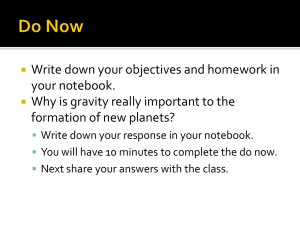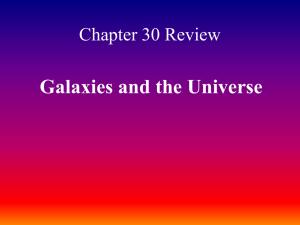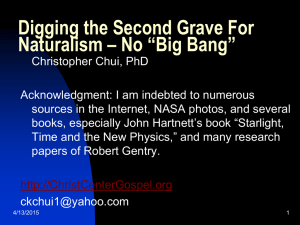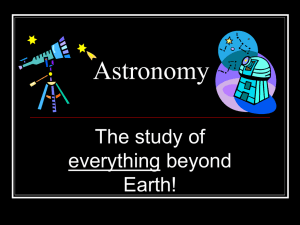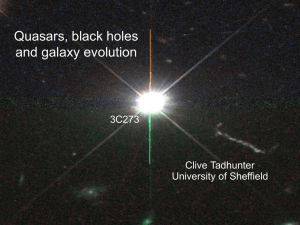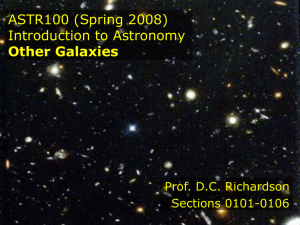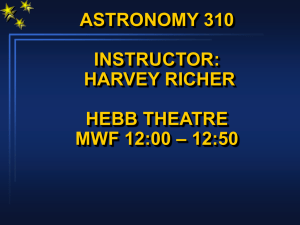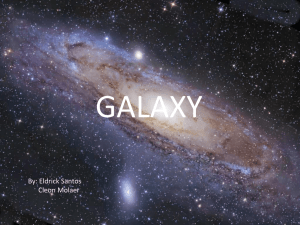Class 28 (Jun 2) - Physics at Oregon State University
advertisement
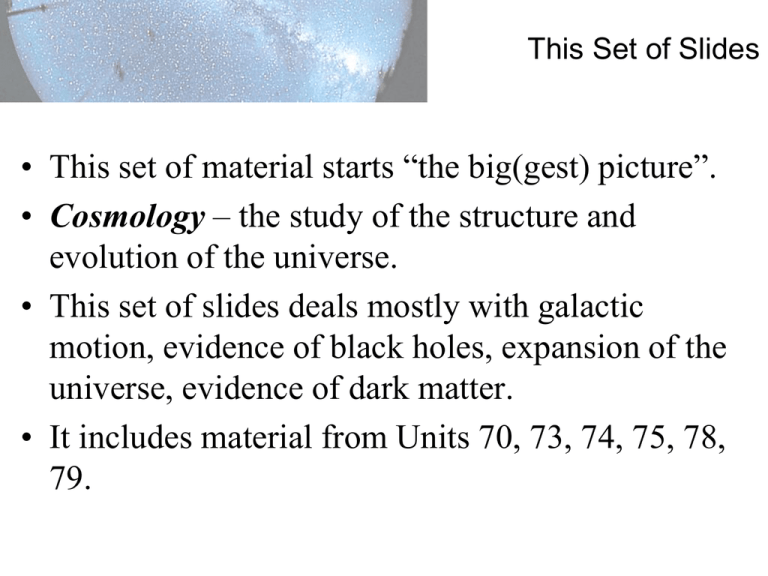
This Set of Slides • This set of material starts “the big(gest) picture”. • Cosmology – the study of the structure and evolution of the universe. • This set of slides deals mostly with galactic motion, evidence of black holes, expansion of the universe, evidence of dark matter. • It includes material from Units 70, 73, 74, 75, 78, 79. Our Galaxy, the Milky Way • A galaxy is a large collection of billions of stars. • The galaxy in which the Sun and our solar system is located is called the Milky Way. • From our vantage point inside the galaxy, the Milky Way looks like a band of stars across the night sky, with dark dust lanes obscuring the center of the band. Rotation in the Milky Way • The Milky Way does not rotate like a solid disk. – Inner parts rotate about the center faster than outer parts. – Similar to the way planets rotate around the Sun. – This is called differential rotation. • A plot of rotation speed vs. distance is a rotation curve. • A star is held in orbit around the galactic center by the gravity of all matter within its orbit. Calculating the Mass of the Galaxy • The rotational velocity of the Sun around the center of the galaxy can be used to estimate the galaxy’s mass. • The combined gravitational effect of all mass within the Sun’s orbit is equivalent to one large lump of mass at the center of the galaxy. • Newton’s Law of Gravitation shows that the mass of all matter within the Sun’s orbit is 91010 solar masses. • We can estimate the mass of the entire galaxy by measuring the orbital velocity of small satellite galaxies in orbit around the Milky Way (21012 solar masses). The Galactic Center and Edge • Despite the appearance of being closely spaced, stars in the Milky Way are very far apart. – At the Sun’s distance from the center, stellar density is around 1 star per 10 cubic parsecs. • Density is much higher at the core – Exceeds 100,000 stars per cubic parsec. • X-ray and gamma ray telescopes reveal a supermassive black hole at the Milky Way’s core. – Called Sag A* – 5 million solar masses! Detecting Black Holes – 2nd Way Sag A* - Our Galactic Center Black Hole Distances to other galaxies • We can use Cepheid variable stars to measure the distance to other galaxies. • A Cepheid’s luminosity is proportional to its period, so if we know how rapidly it brightens and dims, we know much energy it emits. • If we see a Cepheid in another galaxy, we measure its period, determine its luminosity, and calculate its distance. • Distance between galaxies is huge. – M100 is 17 million parsecs away. The Redshift and Expansion of the Universe • Early 20th century astronomers noted that the spectra from most galaxies were shifted towards red wavelengths. • Edwin Hubble (and others) discovered that galaxies that were farther away had even more pronounced redshifts. • This redshift was interpreted as a measure of radial velocity, and it became clear that the more distant a galaxy is, the faster it is receding. The Hubble Law • In 1920, Edwin Hubble developed a simple expression relating the distance of a galaxy to its recessional speed. • V=Hd – V is the recessional velocity. – D is the distance to the galaxy. – H is the Hubble Constant (70 km/sec per Mpc) • This was our first clue that the universe is expanding. The Tuning Fork • Edwin Hubble organized these different galaxy types into a tuning fork shaped diagram. • Ellipticals are labeled E0-E7. – E0 is almost perfectly spherical, E7 is quite flattened. • Spirals are labeled Sa – Sd – Sa galaxies have tightly wound arms and a large central bulge. – Sd galaxies are loosely wound and have a small central bulge. • Barred Spirals are labeled SBa – SBd – Same pattern as the spirals The Tuning Fork, continued • Hubble viewed this tuning fork model as an “evolutionary” model. Galaxies evolved from left to right, forking in the middle for whatever reason (likely gravitational.) • Astronomers today do not believe galaxies evolve along this “tuning fork”. • Still, the model is used for classification. Galactic Collisions • Galaxies can collide, though not in the sense of a car accident. • The galaxies pass through one another, and their immense gravitational pull can tear both galaxies apart. • This can occur with no stars actually colliding! (The space is so enormous!) • Eventually, a new elliptical galaxy will form… Galaxy collision and merger Current galactic evolutionary model. Galactic Rotation Curves • Like a planetary system, galaxies rotate as non-solid disks. (Because they ARE non-solid disks.) • Rotation curve for galaxy is not the same as for a solar system. • It’s flat. But it shouldn’t be. • The outer stars are rotating too rapidly based on visible matter within their orbits. Missing Mass • We can calculate the mass of the Milky Way by measuring the orbital velocities of dwarf galaxies in orbit around our galaxy. • We can also count the number of stars in the galaxy, and estimate the galactic mass. The two numbers do not agree. By a factor of 10! • Rotation curves do not show the expected decrease in stars’ orbital velocities with distance; there must be much more mass present in our galaxy. By a factor of 10! • Astronomers cannot find or see this mass! • We call the missing mass dark matter. Many galaxies have flat rotation curves Dark matter is not unique to the Milky Way. Spiral Galaxy Rotation Curve • 99 percent of the stars in a galaxy are within 20 kpc of the center. • Gas extends far out into the disk, but is not very massive. • Galaxies are now thought to be embedded in a dark-matter halo that surrounds the entire galaxy. • Unfortunately, dark matter cannot be detected directly. Dark Matter Distribution • “Halo” can be misleading – not a ring. • Density of visible matter (stars, dust) in a galaxy is highest in the center but falls off rapidly with distance from center. • Density of dark matter is highest in center of galaxy but falls off gradually and even exists between galaxies. Dark Matter in Clusters of Galaxies • Missing mass is also a problem in clusters of galaxies. Once again, dark matter seems to be the solution – 10 times as much mass as the visible matter. – Not enough visible mass to hold the clusters together by gravitation, and to keep hot gas in their vicinity. – Cluster mass must be 100 times greater than the combined stars. – Gases previously unseen accounts for a tenth. Gravitational Lensing • Dark matter warps space just like ordinary matter does. (General Relativity.) • The path of light rays bends in the presence of mass. • A galaxy or other massive object can bend and distort the light from objects located behind it, producing multiple images. • This is called gravitational lensing. Galactic Cluster Gravitational Lens Amount of matter needed to provided lens effect is 10 times the amount of matter visible (at any wavelength.) 90% of the universe is not detectable to us! What IS Dark Matter? • Unknown. All known matter interacts with SOME wavelength of electromagnetic radiation. • Perhaps small, cold, planet-sized bodies? Cold, dead white dwarfs? Non-rotating neutron stars? Black holes? • MACHOs! Massive, Compact Halo Objects. • Not enough of such things have been detected to make up the quantity of dark matter needed. • Perhaps neutrino-like particles, except massive? • WIMPs! Weakly Interacting Massive Particles. Neutrolinos! • So far? Dark Matter is entirely unlike any matter we are familiar with. The Recession of Galaxies • Recall from Hubble’s Law that the farther away a galaxy is, the faster it is receding from the Milky Way. – V=Hd • This gives the appearance that the Milky Way is at the center of the Universe, and all galaxies are moving away from us, perhaps due to some large explosion (The Big Bang.) • However, Hubble’s Law can be applied to any observer in any galaxy • No matter where you are, an expanding Universe will give this appearance. • This lack of a preferred location in the Universe is called the cosmological principle. An Expanding Universe • The expansion of the Universe is not like the explosion of a bomb sending fragments in all directions through space. • The space itself is expanding! • We can detect photons that appear to have moved at different speeds through space. • • Rather, the speed of light is constant, and it is space that was moving relative to the photon. If each galaxy is like a button attached to a rubber band, an ant walking along the band as it is stretched will appear to have a velocity slower than it really does. The buttons (galaxies) are fixed relative to space, but space itself is moving. Another Analogy • The expansion of the universe and the increasing distance between galaxies is similar to the increase in distance between raisins in a rising loaf of raisin bread. • The raisins are fixed relative to the dough, but the dough expands, increasing the space between them. • Problem with these analogies – loaves and rubber bands have edges. – We have seen no ‘edge’ to the Universe; there are an equal number of galaxies in every direction. – Also, galaxies can move relative to space, as gravity can accelerate one galaxy toward another faster than space expands. The Age of the Universe • Thanks to the Hubble Law, we can estimate the age of the universe. • At some point in the distant past, matter in the universe must have been densely packed. • From this point, the universe would have expanded at some high speed to become today’s universe. • Assuming a constant expansion over time, we find that the age of the universe is around 14 billion years.


